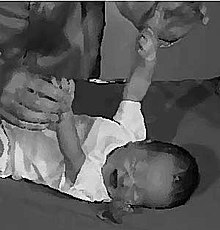Palmar grasp reflex
Palmar grasp reflex (sometimes simply grasp reflex) is a primitive reflex found in infants of humans and most primates. When an object is placed in an infant's hand and the palm of the child is stroked, the fingers will close reflexively, as the object is grasped via palmar grasp. The grip is strong but unpredictable; though it may be able to support the child's weight, they may also release their grip suddenly and without warning. The reverse motion can be induced by stroking the back or side of the hand.[1]

A fetus can exhibit the reflex in utero as early as 16 weeks into the gestation period,[2][3][4][5] and persists until five or six months of age.
Significance
Biologists have found that the reflex is significantly more frequent in infants of fur carrying primate species. They theorize that the grasping reflex evolved as it is essential to survival in species where the young are carried in the fur. This suggests that the grasping reflex is vestigial in humans and in other non-fur carrying primates.[6]
Medical diagnostic
In humans, if the palmar grasp reflex persists beyond 2 to 4 months, it delays or affects functions like grasping a rattle, releasing objects from hand and also hand manipulation skills. Palmar grasp reflex in adults is a pathological frontal release sign and may signify frontal lobe damage, or may be a sign of anterior cerebral artery syndrome.
References
- Futagi, Yasuyuki; Toribe, Yasuhisa; Suzuki, Yasuhiro (2012). "The Grasp Reflex and Moro Reflex in Infants: Hierarchy of Primitive Reflex Responses". International Journal of Pediatrics. 2012: 191562. doi:10.1155/2012/191562. PMC 3384944. PMID 22778756.
- Sherer, DM (June 1993). "Fetal grasping at 16 weeks' gestation". Journal of Ultrasound in Medicine. 12 (6): 316. doi:10.7863/jum.1993.12.6.316. PMID 8515527.
- Jakobovits, AA (2009). "Grasping activity in utero: a significant indicator of fetal behavior (the role of the grasping reflex in fetal ethology)". Journal of Perinatal Medicine. 37 (5): 571–2. doi:10.1515/JPM.2009.094. PMID 19492927. S2CID 26736429.
- Jakobovits, A (2 September 2007). "[Grasping reflex activity in utero is one element of fetal behavior (Grasping activity is a part of fetal ethology)]". Orvosi Hetilap (in Hungarian). 148 (35): 1673–5. doi:10.1556/OH.2007.28089. PMID 17720675.
- Kurjak, A; Stanojevic, M; Andonotopo, W; Salihagic-Kadic, A; Carrera, JM; Azumendi, G (2004). "Behavioral pattern continuity from prenatal to postnatal life--a study by four-dimensional (4D) ultrasonography". Journal of Perinatal Medicine. 32 (4): 346–53. doi:10.1515/JPM.2004.065. PMID 15346822. S2CID 44725653.
- Pouydebat, Emmanuelle; Welser, Kay; Shaw, Erin; Haring, David; Ehmke, Erin; Brewer, David; Wall, Christine E.; Fabre, Anne-Claire; Peckre, Louise (24 November 2016). "Holding-on: co-evolution between infant carrying and grasping behaviour in strepsirrhines". Scientific Reports. 6: 37729. Bibcode:2016NatSR...637729P. doi:10.1038/srep37729. ISSN 2045-2322. PMC 5121892. PMID 27883046.